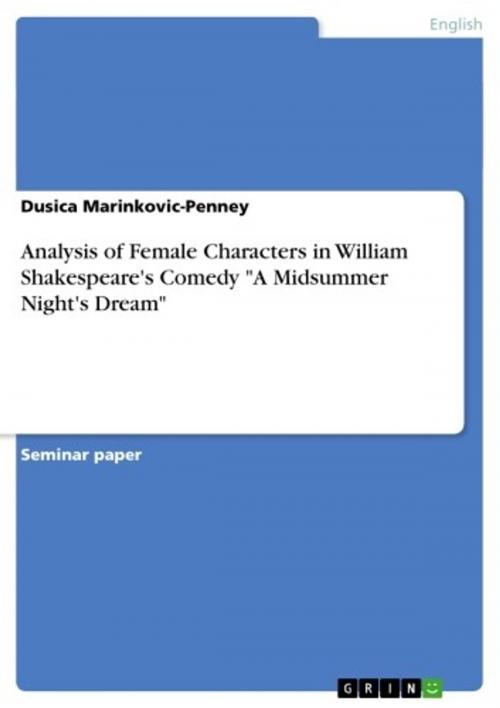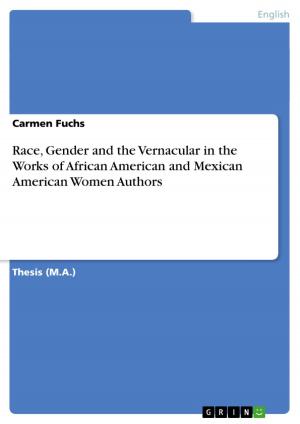Analysis of Female Characters in William Shakespeare's Comedy 'A Midsummer Night's Dream'
Fiction & Literature, Literary Theory & Criticism, British| Author: | Dusica Marinkovic-Penney | ISBN: | 9783640177462 |
| Publisher: | GRIN Verlag | Publication: | September 29, 2008 |
| Imprint: | GRIN Verlag | Language: | English |
| Author: | Dusica Marinkovic-Penney |
| ISBN: | 9783640177462 |
| Publisher: | GRIN Verlag |
| Publication: | September 29, 2008 |
| Imprint: | GRIN Verlag |
| Language: | English |
Seminar paper from the year 2005 in the subject English Language and Literature Studies - Literature, grade: 1, Justus-Liebig-University Giessen (Anglistik), course: Hauptseminar: The History of British Comedy, 12 entries in the bibliography, language: English, abstract: This paper will examine the four female characters of William Shakespeare's comedy A Midsummer Night's Dream which is one of the early comedies of the playwright. Here we encounter four main female characters who come from three different backgrounds. While Hippolyta is about to be married to Theseus, one can say that she represents the leadership in the mortal world. Titania is another leading character who is the queen of the fairy land. Hermia and Helena represent young women who are trying to find the right partner for themselves. As in many Shakespeare's comedies, the married couples are confronted with a certain problem that seems to endanger their marriage, while the unmarried people make choices that are not accepted or a confusing love constellation exists, for instance the 'love chain' that can be found in this play, where Helena loves Demetrius who loves Hermia who loves Lysander. The play can be divided into three parts: at the beginning we face a world of Athens, where life is organized by law; the middle part of the play takes place in the magical wood where the fairies control the irrational events and cause a lot of discord, and finally a return to the 'normal' world occurs where all the mismatched couples can resolve their troubles and a triple wedding takes place which is the ultimate happy end for a comedy of Shakespeare's times. All four female characters will be analyzed in all three stages of the play: before the magic intervention of the fairy king, during the confusion caused by him and after the initial conditions are restored. Hippolyta remains the only character who is not manipulated by the love potion. The female characters will be analyzed according to their behavior, their image of themselves and the relationship to the men. Each character will be introduced and analyzed in a separate chapter. The goal is to find parallels and contrasts between these characters which will be presented in the conclusion of this paper.
Seminar paper from the year 2005 in the subject English Language and Literature Studies - Literature, grade: 1, Justus-Liebig-University Giessen (Anglistik), course: Hauptseminar: The History of British Comedy, 12 entries in the bibliography, language: English, abstract: This paper will examine the four female characters of William Shakespeare's comedy A Midsummer Night's Dream which is one of the early comedies of the playwright. Here we encounter four main female characters who come from three different backgrounds. While Hippolyta is about to be married to Theseus, one can say that she represents the leadership in the mortal world. Titania is another leading character who is the queen of the fairy land. Hermia and Helena represent young women who are trying to find the right partner for themselves. As in many Shakespeare's comedies, the married couples are confronted with a certain problem that seems to endanger their marriage, while the unmarried people make choices that are not accepted or a confusing love constellation exists, for instance the 'love chain' that can be found in this play, where Helena loves Demetrius who loves Hermia who loves Lysander. The play can be divided into three parts: at the beginning we face a world of Athens, where life is organized by law; the middle part of the play takes place in the magical wood where the fairies control the irrational events and cause a lot of discord, and finally a return to the 'normal' world occurs where all the mismatched couples can resolve their troubles and a triple wedding takes place which is the ultimate happy end for a comedy of Shakespeare's times. All four female characters will be analyzed in all three stages of the play: before the magic intervention of the fairy king, during the confusion caused by him and after the initial conditions are restored. Hippolyta remains the only character who is not manipulated by the love potion. The female characters will be analyzed according to their behavior, their image of themselves and the relationship to the men. Each character will be introduced and analyzed in a separate chapter. The goal is to find parallels and contrasts between these characters which will be presented in the conclusion of this paper.















